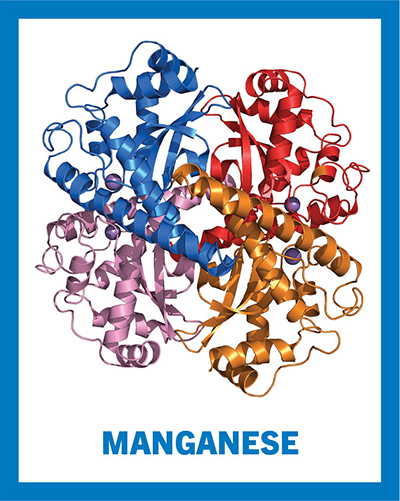Manganese seldom travels alone
We mark the 150th anniversary of Dimitri Mendeleev’s periodic table of chemical elements this year by highlighting elements with fundamental roles in biochemistry and molecular biology. So far, we’ve covered hydrogen, iron, sodium, potassium, chlorine, copper, calcium, phosphorus, carbon, nitrogen and oxygen.
 This ribbon diagram represents the structure of the human superoxide dismutase 2 tetramer in coordination with four manganese ions shown in violet.Fvasconcellos/Wikimedia Commons
This ribbon diagram represents the structure of the human superoxide dismutase 2 tetramer in coordination with four manganese ions shown in violet.Fvasconcellos/Wikimedia Commons
For September, we describe manganese, a transition metal with chemical symbol Mn and atomic number 25. Manganese is highly reactive, and it almost never is found as a free element in nature. Rather, it combines with other elements via its multiple oxidation states, which range from +7 to -3. It frequently is found in silicate, carbonate and oxide minerals, and in alloys — compounds containing metals — with iron. People used manganese-containing pigments that are naturally abundant in cave paintings dating back to the Stone Age.
Nuclear reactions that occur in giant stars immediately before supernova explosions produce manganese. It has a short half-life of about 3.7 million years and decays into one of the four chromium isotopes — element variants with different numbers of neutrons. At 0.1%, manganese is the 12th most abundant element on the Earth’s crust. A significant amount of manganese is present on the ocean floor in the form of manganese nodules — specific marine deposits composed by manganese hydroxide and iron.
In living systems, that combine with biological molecules in the aqueous environment of the cell. Mn+2 often overlaps and competes with magnesium and calcium ions as a structural component that stabilizes the net charge of molecules such as proteins and adenosine triphosphate. As a redox cofactor for a large variety of enzymes, manganese is at the catalytic center for cellular reactions that participate in aerobic metabolism.
Manganese is vital to microbial survival. Protein transporters in bacteria break down high-energy chemical bonds in adenosine triphosphate to drive the influx of manganese into the cell from the extracellular environment. Bacterial species of the normal flora of the human digestive and reproductive systems require manganese for survival and growth. The Lyme disease pathogen Borrelia burgdorferi can incorporate manganese in all of its metalloproteins, bypassing host defense by . The diphtheria toxin secreted by the pathogen Corynebacterium contains manganese in its structure. Some bacteria use nonenzymatic Mn+2 ion complexes — generally in combination with polyphosphate — to scavenge reactive oxygen species that are byproducts of cellular metabolic reactions.
In yeast and other eukaryotes, the natural resistance-associated macrophage protein, or NRAMP, uptake manganese using the driving force of proton gradients. Once inside cells, manganese serves as a cofactor for a multitude of enzymes that include oxidoreductases, carbohydrate-binding proteins such as lectins, and extracellular matrix receptors such as integrins.
Superoxide dismutase, an important manganese-containing enzyme present in mitochondria — and in most bacteria — partitions harmful reactive superoxide ions into molecular oxygen or hydrogen peroxide, protecting cells from the toxicity associated with aerobic respiration. In plants and cyanobacteria, manganese is an essential component of the enzyme responsible for the terminal oxidation of water during the light reactions of photosynthesis.
A year of (bio)chemical elements
Read the whole series:
For January, it’s atomic No. 1
For February, it’s iron — atomic No. 26
For March, it’s a renal three-fer: sodium, potassium and chlorine
For April, it’s copper — atomic No. 29
For May, it’s in your bones: calcium and phosphorus
For June and July, it’s atomic Nos. 6 and 7
Breathe deep — for August, it’s oxygen
Manganese seldom travels alone
For October, magnesium helps the leaves stay green
Enjoy reading 91Ó°żâToday?
Become a member to receive the print edition four times a year and the digital edition monthly.
Learn moreGet the latest from 91Ó°żâToday
Enter your email address, and we’ll send you a weekly email with recent articles, interviews and more.
Latest in Science
Science highlights or most popular articles

Hope for a cure hangs on research
Amid drastic proposed cuts to biomedical research, rare disease families like Hailey Adkisson’s fight for survival and hope. Without funding, science can’t “catch up” to help the patients who need it most.

Before we’ve lost what we can’t rebuild: Hope for prion disease
Sonia Vallabh and Eric Minikel, a husband-and-wife team racing to cure prion disease, helped develop ION717, an antisense oligonucleotide treatment now in clinical trials. Their mission is personal — and just getting started.

Defeating deletions and duplications
Promising therapeutics for chromosome 15 rare neurodevelopmental disorders, including Angelman syndrome, Dup15q syndrome and Prader–Willi syndrome.

Using 'nature’s mistakes' as a window into Lafora disease
After years of heartbreak, Lafora disease families are fueling glycogen storage research breakthroughs, helping develop therapies that may treat not only Lafora but other related neurological disorders.

Cracking cancer’s code through functional connections
A machine learning–derived protein cofunction network is transforming how scientists understand and uncover relationships between proteins in cancer.

Gaze into the proteomics crystal ball
The 15th International Symposium on Proteomics in the Life Sciences symposium will be held August 17–21 in Cambridge, Massachusetts.

